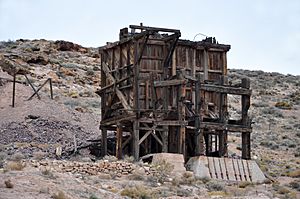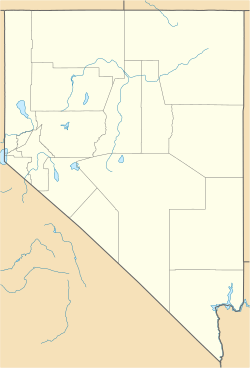Pioneer, Nevada facts for kids
Quick facts for kids
Pioneer, Nevada
|
|
|---|---|

Ruins at Pioneer, Nevada, a former mining town
|
|
| Country | United States |
| State | Nevada |
| County | Nye |
| Elevation | 4,222 ft (1,287 m) |
| Population
(1908)
|
|
| • Total | ~2,500 |
| Time zone | UTC-8 (Pacific (PST)) |
| • Summer (DST) | PDT (UTC-7) |
Pioneer is a ghost town located in Nye County, in the state of Nevada, USA. It started as a small camp for gold miners near the Mayflower and other gold mines. The town officially began in 1908 and quickly grew. However, a big fire in 1909 destroyed many businesses. Also, legal problems slowed down the mining work.
At its busiest in 1908, about 2,500 people lived in Pioneer. The town continued to exist until its post office closed in 1931. Mining kept going near the town until 1941. Today, not many buildings are left from Pioneer's past.
Contents
Where Was Pioneer Located?
Pioneer was built on the north side of the Bullfrog Hills. You could reach it by taking Pioneer Road, which was a gravel road off U.S. Route 95.
- It was about 7 miles (11 km) north of Beatty.
- It was also about 8 miles (13 km) northeast of the ghost towns Rhyolite and Bullfrog.
- Las Vegas was much further away, about 130 miles (209 km) to the northwest.
There were desert springs nearby, about 2 to 4 miles (3 to 6 km) east of Pioneer. These springs were part of the Oasis Valley of the Amargosa River. Donovan Mountain, in the Bullfrog Hills, rises to 5,597 feet (1,706 meters) above sea level close to the town. The edge of Death Valley National Park was only about 3 miles (5 km) further west.
How Pioneer Began and Grew
Pioneer started as a simple mining camp. It was near gold mines like the Mayflower and Pioneer mines, which were part of the larger Bullfrog Mining District. This district also included mines in Rhyolite and Bullfrog.
A rich businessman named Charles M. Schwab invested in the Mayflower mine in 1906. In 1908, a company was formed to create the town of Pioneer. They started building roads and selling plots of land.
Early Transportation
In 1908, a stagecoach began running daily between Pioneer and Springdale, another mining town about 2 miles (3 km) northeast. Springdale was on the Bullfrog Goldfield Railroad. By 1909, another daily stagecoach connected Pioneer and Rhyolite. A special road was built just for this route.
As mines near Rhyolite started to slow down, some miners and businesses moved to Pioneer. Some even moved their entire buildings! For example, a group of investors bought the Montgomery Hotel in Beatty and moved it to Pioneer in February 1909. They renamed it the Holland House, which became the most impressive building in Pioneer.
Pioneer's Peak and Challenges
By the spring of 1909, Pioneer's population had grown to about 2,500 people. There were around 300 buildings in the town. The federal government even approved a post office for Pioneer in March 1909. Besides stagecoaches, early cars also carried people between Pioneer and the train station in Rhyolite.
Water was brought in barrels from Springdale and Crystal Springs, which were about 3 miles (5 km) away. For about five months in 1909, Pioneer had two weekly newspapers: the Pioneer Topics and the Pioneer Press.
The town had many businesses, including:
- A drug store
- A doctor's office
- A barber shop
- Restaurants
- A liquor store
- Saloons
- A meat market
- A general store
- A bank
- Boarding houses (places to stay)
- The Holland House hotel
Just after the town reached its busiest time in March and April 1909, a big fire happened on May 9. It destroyed much of the business area. Even though the town tried to rebuild and continued to do well for a while, the excitement was never quite the same.
Decline of the Town
After the fire, the town rebuilt its business district. A school opened in mid-1909 with 44 students. Several mines kept paying their workers, which helped Pioneer survive through the end of the year. However, legal battles over who owned the Mayflower and other mines slowed down work. This stopped the town's growth.
By the fall, only 24 students were left in the school. At the start of 1910, residents even held a "Hard Times Dance" at the Holland Hotel. More arguments about mine ownership and the failure of a bank in Rhyolite made things worse for Pioneer. Stores began to close. In August 1910, the Holland Hotel was sold because of unpaid taxes.
A smaller number of people continued to live in or near Pioneer for many years. The post office stayed open until early 1931. Mining continued in the area through the 1930s but stopped in 1941. It did not start up again on a large scale after World War II.
By 2004, not much was left of Pioneer. You could find some scattered debris, flat areas where buildings once stood, a few pieces of wood, and maybe some foundations. Nearby, you could still see parts of the Mayflower mine's headframe (a structure over a mine shaft) and ore bin (where mined rock was stored).


